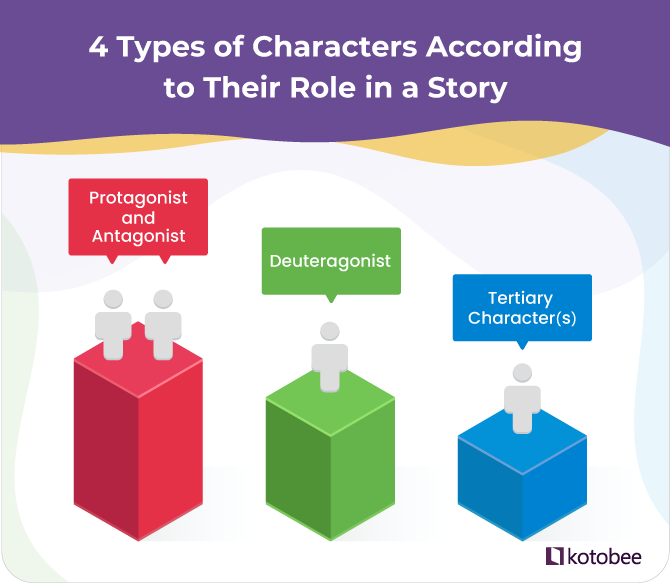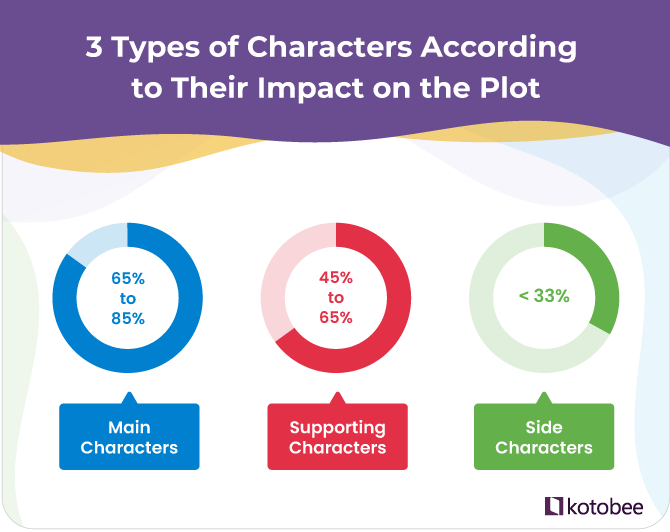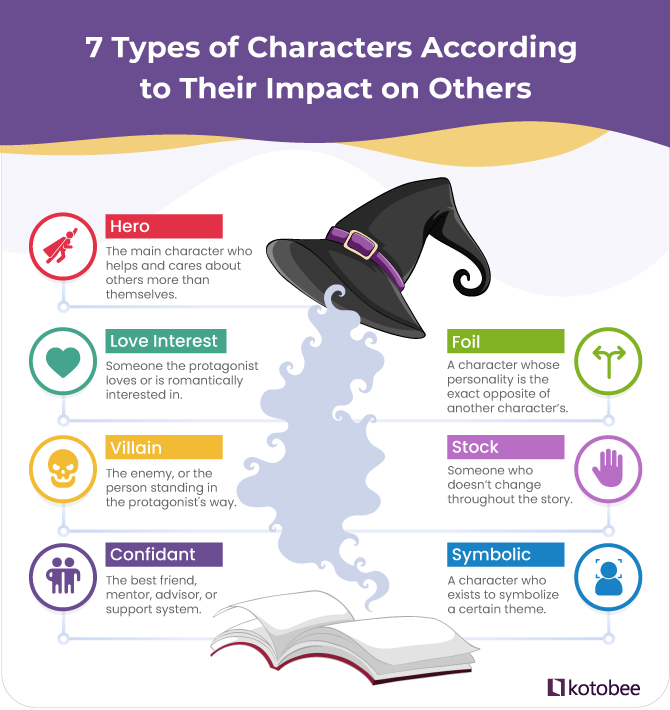Characters function the soul of any story. They’re the changemakers, the chess items that act and react to 1 one other in a series of occasions referred to as the plot. So, it’s fairly vital to know the several types of characters in literature and the best way to create them.
As you’re writing your story, you’ll find your self giving your characters sure roles or making a few of them extra vital to the plot than others. In flip, the extra vital characters will characteristic in most scenes, whereas much less vital characters will solely seem now and again. With follow, you’ll finally be taught to insert the best varieties of characters in the best locations with out giving it a lot thought.
That can assist you try this, we’ll discover the several types of characters in a narrative. We’ll use three classification techniques: their significance within the story, their significance to the plot, and their relationships to 1 one other.

Why Ought to You Know the Completely different Kinds of Characters in Fiction?
Understanding numerous character sorts might help you create extra compelling characters. Since every kind performs a definite position in a narrative, selecting a sure position considerably impacts the character’s emotions, actions, and significance to the narrative. Moreover, realizing these sorts permits you to differentiate between characters with comparable personalities, as their roles throughout the story could fluctuate.
That can assist you perceive all the different sorts, we’re going to discover three approaches to classifying characters. Why three? As a result of a single character can symbolize a number of sorts on the identical time. For instance, a single character could be the protagonist, one of many predominant characters, and even a villain. One other character might be each a deuteragonist and likewise a symbolic predominant character.
These numerous roles add layers of complexity and depth to every character. So, counting on only one classification system limits the quantity of non-public depth we are able to infuse into our fictional creations.
The 4 Kinds of Characters In line with Their Roles in a Story
On this part, we’ll outline the several types of characters in response to the alternatives they make and the results of those decisions on the plot.
1. Protagonist
A protagonist is the principle character whose journey we comply with all through the story. To make that journey extra attention-grabbing, writers add depth and weight to the protagonist’s persona, backstory, and any progress they expertise within the story. So, we regularly kind attachments to those characters and prefer to see them develop into higher individuals or reach attaining their targets.
Nevertheless, not all protagonists embark on epic journeys or have likable personalities. A few of them become fairly dreadful individuals! Shakespeare’s Macbeth, as an example, begins out as a noble common who turns into consumed by greed and ambition as he tries to safe the throne for himself.
2. Antagonist
Wherever there’s a protagonist, there’s additionally an antagonist who causes conflicts that get in the way in which of the protagonist. Whereas antagonists sometimes possess evil intentions or plans, there are cases the place they become good guys (particularly when the protagonist is revealed to be the true villain).
A superb instance of a traditional antagonist is Sir Leigh Teabing from The Da Vinci Code. He’s secretly the mastermind behind the murders of the Priory of Sion members who shield the Grail.
3. Deuteragonist
A deuteragonist is a personality who’s vital to the story however not sufficient for the story to focus solely on them. Whereas not fairly the principle character, a deuteragonist has their very own unbiased story to inform. They often seem as associates of the protagonist or antagonist, however they might perform individually from each. You may say that they arrive proper after the protagonist and antagonist when it comes to significance.
Some well-known examples of deuteragonists are Dr. Watson from Sherlock Holmes and Harvey Dent in The Darkish Knight.
4. Tertiary Characters
These characters have small roles within the restricted scenes they seem in. Although tertiary characters could appear unimportant, it’s a must to give them sufficient weight so their position within the scene is significant. These roles can vary from comedian reduction to kickstarting plot occasions. For example, consider a waiter serving the protagonist’s desk, a pilot flying the antagonist’s airplane, or a villager shopping for from a close-by market stall.
The unfortunate cabbage vendor from Avatar: The Final Airbender is among the most memorable tertiary characters amongst followers of the present. His appearances, whereas transient, flip into operating gags that by no means fail to make the viewers snort.

3 Kinds of Characters In line with Their Impression on the Plot
In any story, a personality’s significance will be decided by their impression on the plot or different characters. Typically, characters with larger impression seem extra typically within the story than others. Based mostly on this, we are able to categorize characters into three sorts in response to how typically they seem within the story.
1. Most important Character
This character kind takes up greater than two-thirds of the story in scene time and participates in many of the plot occasions. Protagonists, antagonists, and even deuteragonists—relying on their story arcs—can depend as predominant characters.
Harry Potter is a well-liked instance of a predominant character whose journey we comply with in depth all through a complete guide (and franchise).
2. Supporting Character(s)
Whereas much less vital than the principle character, these characters nonetheless play vital roles within the story and often seem in about half of the plot occasions.
They’ll act as shut buddies, advisory figures, and even minor villains who assist the antagonist. As such, deuteragonists, minor antagonists, and a few tertiary characters match into this class. Consider Ron and Hermione, who accompany Harry Potter all through their years at Hogwarts.
3. Aspect Characters
These characters take up not more than a 3rd of the story if not only a scene or two. Thus, they have an inclination to serve minor roles and infrequently don’t keep lengthy sufficient to go away lasting impacts on story occasions. Remus Lupin and Luna Lovegood from Harry Potter are thought of facet characters as a result of their display screen time is far lower than others.

7 Kinds of Characters In line with Their Impression on Others
Lastly, we’ll speak about character sorts as specified by their behaviors and relationships with others. Whereas these characters will not be stable archetypes, the next classification will make it easier to perceive how they work together with each other.
1. Hero
A hero is an individual whose mission is to assist others in any capability. They could carry out acts of kindness akin to giving beneficiant donations to a charity, brewing espresso for a drained coworker, or rescuing a toddler from kidnappers.
When a personality acts as a hero, they depend on their morals to do the best factor, placing others’ well-being earlier than themselves even at their very own expense.
Heroes typically function the protagonists in a hero-vs-villain story, like Frodo from Lord of the Rings.
2. Love Curiosity
Though not all tales comprise romance, many characters could wish to pursue a particular somebody. This love story may function the principle plot or a facet arc, relying in your guide’s style and the characters’ personalities.
As with different central characters, love pursuits ought to be developed completely when launched into the story. They need to even be given the identical degree of depth and complexity to make them compelling and memorable. In spite of everything, it’s that complexity and intriguing persona that turned Catherine Earnshaw from Wuthering Heights right into a compelling love curiosity. It additionally contributed to the novel turning into a preferred and well-loved traditional.
3. Villain
Whether or not they scheme of their towering castles or scare individuals with one take a look at a company assembly, villains add larger stakes to a narrative by introducing exterior battle. They might be evil past redemption or have a couple of good traits that make them appear extra human.
In all circumstances, villains are inclined to trigger huge issues all through the story, identical to the Joker does for Batman via breaking out of jail and terrorizing the town.
4. Confidant
Confidants provide a assist system for the principle characters, grounding them after they fall or doubt themselves. They’ll seem as their finest buddies or mentors, they usually provide assist and encourage the protagonist to beat any obstacles of their path. Nevertheless, they could additionally function crafty advisors to the villain of the story as nicely.
For instance, Mr. Miyagi serves as a confidant to Daniel in The Karate Child, educating him each bodily martial arts and the psychological abilities to go along with it.
5. Foil
A foil is a personality whose persona, actions, or existence contrasts with that of one other character. Writers typically use foils to emphasise sure qualities in a personality, whether or not it’s the protagonist or others. Consequently, foils are more practical after they seem continuously and work together with the character they’re designed to distinction.
One of many clearest examples of such a personality is Helen Burns in Jane Eyre, who serves as a foil to the college supervisor, Mr. Brocklehurst. She is sort and forgiving, whereas Mr. Brocklehurst frequently punishes and screams at college students even when they did nothing incorrect.
6. Inventory Characters
Inventory characters are sometimes flat and expertise no character progress all through the story. Accordingly, they preserve their shallow and predictable persona traits starting to finish. Chances are you’ll know inventory characters as stereotypes, archetypes, cliches, or easy, flat characters that don’t have any complexity to them.
On condition that they don’t expertise character progress, inventory characters are perfect for one-off scenes or plotlines by which character progress is unimportant to the story. While you use a inventory character in a scene, you emphasize the plot occasions taking place to them as a substitute of the character’s reactions to those occasions.
Dr. Frankenstein from Frankenstein, for instance, is a real mad scientist whose ardour for science steered him into unethical experiments that created a monster. Regardless of going through extreme issues due to his experiments, Dr. Frankenstein’s shallow persona stays the identical till the top. Moreover, the middle level of the story is the experiments, not the person himself.
7. Symbolic Characters
Lastly, we have now symbolic characters whose predominant function is as an instance a particular thought or idea. Their actions—which are sometimes exaggerated—have a tendency to emphasise a sure theme within the story.
As an illustration, a personality could symbolize dedication and braveness by refusing to surrender their quest within the face of not possible odds. One other character could symbolize the ideas of greed and corruption as a result of they revenue off of unlawful enterprise practices.
One good instance is the White Rabbit from Alice in Wonderland, who continuously checks his pocket watch and rushes from place to position, thus symbolizing the significance of time.

Ultimate Ideas
Studying in regards to the several types of characters in fiction might help you design well-developed ones and give you appropriate conflicts in the long term.
To know the assorted varieties of characters in fiction, you possibly can learn your favourite books and level out character roles you didn’t give a lot thought to earlier than. Doing this might help you find out how characters’ roles can have an effect on their actions and assist transfer the plot ahead. You additionally get to see for your self how numerous only one character kind will be!
.
Learn Extra
What Is a Memoir and Find out how to Write an Excellent One?

